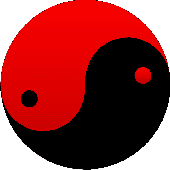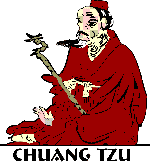

In daily life we can be so preoccupied with external things that we do not live but are being lived. We do not walk; we run. Our eyes strain under an endless stream of images: streets, walls, faces, newspapers, television. Our ears take in the continuous noise of screeching traffic, prattling talk, pulsating music. We are under pressure. We have to succeed. We are meeting minimum standards and deadlines. Competition impels us forward; so does the clock. Hardworking achievers as we are, we drive ourselves on. Then, in the evening, flushed and fatigued by the day's activity, we get drunk on newsy thrills or intoxicating fiction - till we pass out. And this we call living.
To escape this fate we should listen to the advice of the ancient Chinese masters, the Taoists, who tell us to learn non-action.
Lao Tzu recorded a warning in his Tao Te Ching:
Block your mouth,
shut the doors of eyes and ears,
and you will have fullness within.
Open your mouth,
be always busy,
and you're beyond hope!
Tao Te Ching 52,2
If we are honest we know that he is offering valuable advice.
Yes, we have to stop running. We have to guard our senses; or we will run dry. But what exactly did the ancient Chinese master mean? Was he talking about the same problems that afflict us today? How, in fact, can we presume that someone who lived twenty-three centuries ago, and in a country so far removed from our own, has anything sensible to say to people who live here and now?
I believe the original Taoist thinkers should be listened to for two reasons. First, they reacted to hectic social and political conditions that were not so different from our own. Secondly, in formulating a solution they drew on their own deep mystical insights; so that the truths they expressed retain lasting validity. A ruby set in a gold ring may have been fashioned for a princess whose name is forgotten; it retains its beauty because the quality of its material and the skill of its craftsmanship do not diminish with time.
To understand why the Taoist masters recommended non-action, we must know that the daily life of Chinese leaders was an unending chain of work, competition, fights and anxiety. Chuang Tzu who had been a court official, withdrew to a solitary place for leisure and thought. The king of the State of Ch'u wanted to enlist Chuang Tzu's services. He despatched two envoys with a letter that stated: "Hereby I appoint you my chancellor." The envoys delivered the message to Chuang Tzu as he stood knee-deep in Pu river, fishing with a bamboo pole.

Still holding his pole and looking speculatively at Pu river, Chuang Tzu said:
"I believe there is a sacred turtle, offered and canonized three thousand years ago, which is worshipped by the king. Wrapped in silk it lies in a precious shrine on an altar in the temple.
What do you think?
If you were a turtle, would you prefer to lose your life and leave your dead shell to be an object of worship shrouded in incense for three thousand years?
Or would you prefer to live as a plain turtle that drags its tail in the mud?"
The envoys replied:
"The turtle might prefer to stay alive and drag its tail in the mud!"
"Precisely", Chuang Tzu replied. "Go home. Leave me here to drag my tail in the mud.'
Was Chuang Tzu speaking of physical survival? Perhaps, yes. Prime ministers led conspicuously short lives in those days, and few came unscathed through incessant bloody court intrigues. A king might overwhelm an official with favours one day; and then cheerfully chop off the man's toes the next, at the request of one of his consorts. But physical survival was not his first or main concern. He was thinking of his survival as a person, as a human being.
Turtles were used in China for fortune telling. Though this will have played a part in Chuang Tzu's answer, his main lesson concerned the live turtle itself.
A turtle is useless on land. When threatened it pulls in all its limbs and lies rigid as a stone. But when it moves in its own space, in the muddy water of the river, it darts along, happy and agile. The lesson of the turtle is that it can only grow and be happy in its natural surroundings.
How does this apply to human beings? Where is our "space", our natural surrounding? Do we find it in competition, warfare, ambitious production? Do we obtain it by victory, power, wealth? Or does it lie on a deeper plane - when we discover what it means to be human?
Chuang Tzu sums it up in this way:
Fish thrive in water;
human beings thrive in Tao.
Water animals seek the deep shadow of the pool
and satisfy their needs.
If human beings who thrive in Tao
immerse themselves in non-action,
their nature is realized.
The lesson is:
Fish need to lose themselves in rivers and lakes,
people in the practice of Tao.
Chuang Tzu 6,11
For a human being to survive as a human being , we need to loosen ourselves from constant mindless activity, we need to be inwardly detached from our work, we need to mentally and emotional withdraw from all external involvement. This inner withdrawal is called "wu-wei", non-action.
If we practice non-action, we open ourselves to Spiritual Reality, the Tao..
It is characteristic for human beings to be happy when we open ourselves to this spiritual dimension. Though external involvement is necessary and fruitful, it only makes sense if we have first discovered depth and truth in ourselves. The Taoists did not preach escape. What they advocated was the return to deeper waters where the human spirit could discover its own worth.This meant: withdrawing from external noise and diving into an alert silence.
The silence which we have begun practicing in Day One and Day Two, needs now to be consciously related to our external involvements: our talk and our work.
We must withdraw from all the talk we have listened to and all the talk we have engaged in during the day. This will help us temper the inner turmoil of our thoughts and words.
Why do we talk so much? The Tao Te Ching points out how hollow and shallow talk can be.
Honest words are not beautiful;
beautiful words are not honest.
The more words, the less they count.
Who strides cannot maon't boast or brag.
intain the pace.
Who knows does not speak;
who speaks doesn't know.
Talking little is only natural.
Gusty winds don't last all morning;
downpours cannot last all day.
A truly wise person is not a chatterbox. "The best guide teaches without words. The master instructs his disciples in non-talking . Only thus can the Tao be found."
Our soul has, as it were, been silted up by successive deposits of talk, work and trouble. Travelling back through these layers of external consciousness, we have to "return to stillness". It is in the point of original stillness that we discover our true self, says the Tao Te Ching.
We must detach ourselves inwardly from all external activity.
In practical terms this involves withdrawing inwardly from all our external work. First we remember the hurry and worry of the day, then we consciously pull back. We recognise the limited value of all of it. We purposely withdraw. The Taoists called this tso-wang, sitting with an empty mind. By a cessation of outside impressions and the withdrawal of the senses to an interior point of focus, calm and quiet may be found. Silence functions as healing.
The heavy underlies lightness.
The still overcomes unrest.
Empty yourself of everything.
Let your mind hold to stillness.
The ten thousand things rise and fall while the Self watches their return.
They teem and flourish, then return to the source.
Returning to the source
is stillness which is the way of nature.
Movement generates heat,
but stillness overcomes it.
Stillness
and tranquillity
set things in order in the universe.
When you reach inner stillness, open yourself to the spiritual dimension.
"Our mind benefits greatly from peace and stillness.
Do not fret, do not allow yourself to be upset and the experience of deep harmony will come, of its own accord. It is close at hand, standing at the door; yet is intangible, outside our conscious control. It may seem as distant as the furthest limit of the universe; yet it is not far off. Every day we can drink its power.
For Tao fills us completely but we cannot pin it down. It leaves us, yet has not departed. It arrives and is not around. It is silent, producing no sound that can be heard; but suddenly it is present in the mind. It is hazy and dark, has no distinct contours, yet in a great stream it flowed into us at birth.''
Kuan Tzu in P'ien c.49.
Text from: JOHN WIJNGAARDS, God Within Us, Fount Paperbacks, London 1988; Templegate, Springfield, Illinois 1990.